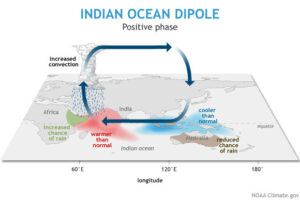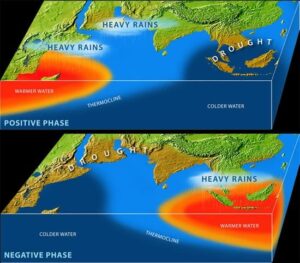Ibebuchi, C. C., 2023: Circulation patterns linked to the positive sub-tropical Indian Ocean dipole. Adv. Atmos. Sci., 40(1), 110−128, https://doi.org/10.1007/s00376-022-2017-2.
****************************************************
Climate and weather patterns have always been discussed hand in hand. However, there has been historical and present-day bias in where most of those studies occur. Two areas that have historically received less attention, and continually in the era of climate change are the Indian Ocean and parts of Africa south of the equator. The subtropical Indian Ocean dipole (SIOD) is one of the climatic modes (a natural form of climate variability) in the subtropical southern Indian Ocean that influences the austral (southern hemisphere) summer inter-annual (occurring between years, or from one year to the next) rainfall variability in parts of southern Africa.
Source: NOAA Climate.gov
Now, this may be information overload, so let’s try to break things down.
Essentially, these authors were trying to understand the relationship between rain circulation types in the summer in Africa south of the equator, where there was a relationship to SIOD dynamics, and the dynamics through which given spatial regions receive a specific rainfall, and of how this can be influenced by “positive” SIOD. Positive phases in climate conditions, according to NOAA, essentially mean that the climate jet stream (narrow bands of strong wind in the upper levels of the atmosphere) stays farther north, and mid-latitude winters are milder than usual. Conversely, the jet stream dips into the mid-latitudes, creating cold-air outbreaks, during the negative phase.
The authors obtained four austral summer “rain-bearing” circulation types (what the called CTs) for this paper. The CT that featured (1) enhanced cyclonic activity in the southwest Indian Ocean, (2) positive widespread rainfall anomaly in the southwest Indian Ocean, and (3) low-level convergence of moisture fluxes from the tropical South Atlantic Ocean, tropical Indian Ocean, and the southwest Indian Ocean, over the south-central landmass of Africa, were found to be related to the positive SIOD climatic mode.
So, what?
Well, this relationship also implies that positive SIOD can be expected to increase the amplitude and frequency of occurrence of the CTs mentioned earlier. Basically, through the large-scale patterns of atmospheric circulation associated with the CT, the SIOD can influence the spatial distribution and intensity of rainfall over the preferred landmass through enhanced moisture convergence.
So, knowing this, let’s back up to understand a little bit more about what the authors were seeking, why it matters, and what this has to do with oceans themselves.
The inter-annual variability of rainfall in southern Africa during austral summer is to a large extent related to sea surface temperature (SST) anomalies in the southwest Indian Ocean. It was also interesting to note that climatic modes in the south Indian Ocean are known to be associated with extreme weather events (EWEs) in southern Africa, such as droughts and floods, and can influence the spatial pattern and frequency of tropical cyclones in the south Indian Ocean (a topic I have published work on myself!).
Source: Woods Hole Oceanographic Institution
Therefore, the most important thing to note from this study is that its dedication to understanding the relationship between positive SIOD climatic modes and the austral summer rain-bearing CTs in Africa south of the equator is to better understand how this interaction can influence large-scale patterns of atmospheric circulation. This is important because the positive SIOD might influence the intensity and spatial distribution of rainfall at specific regions in Africa south of the equator.
The authors analyzed a 40-year dataset, from 1979 to 2019. They used different indices and theorems to classify circulation types and better understand the SIOD as well as to understand circulation types in Africa south of the equator.
In conclusion, their final discoveries were that:
(a) the positive phase of the subtropical Indian Ocean dipole modulates circulation patterns in Africa south of the equator;
(b) through the modulation of circulation patterns, summer rainfall variability at the south-central parts of Africa are significantly impacted, and;
(c) the enhanced convective (convection currents) activity in parts of the southwest Indian Ocean contribute to above-average rainfall at the south central parts of Africa.
Source: Woods Hole Oceanographic Institution
For real-world applications, one of the interesting case studies for a paper like this is, for instance, confirming that enhanced cyclonic activity (i.e., warmer sea surface temperatures and convective activity) in the Mozambique Channel and the northern Agulhas current can result in more advective moisture fluxes from the marine regions, and are among the basic mechanisms through which the positive SIOD cause above-average rainfall in the south-central parts of Africa south of the equator.
Krti is interested in the transmission dynamics of environmental diseases as they relate to climate and anthropogenic stressors. As a Fulbright Scholar, Krti conducted analyses on the responses of dengue fever to climatic stressors off the coast of the Bay of Bengal, in India. Currently, Krti works with Stanford University to understand the role of schistosomiasis in environmental reservoirs, and leads the pursuit of a computational-based based analysis of eelgrass wasting disease dynamics. At Stanford, Krti serves as one of the few trans-disciplinary experts for planetary health topics, via machine learning and computer vision, data science, environmental policy, and science communication. As a STEM innovator and a first-generation woman of color, Krti is proud to be a writer for Oceanbites!




